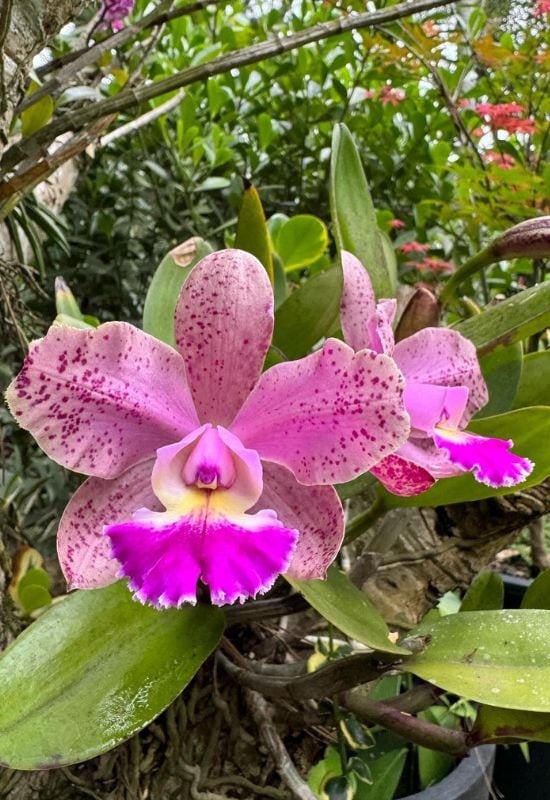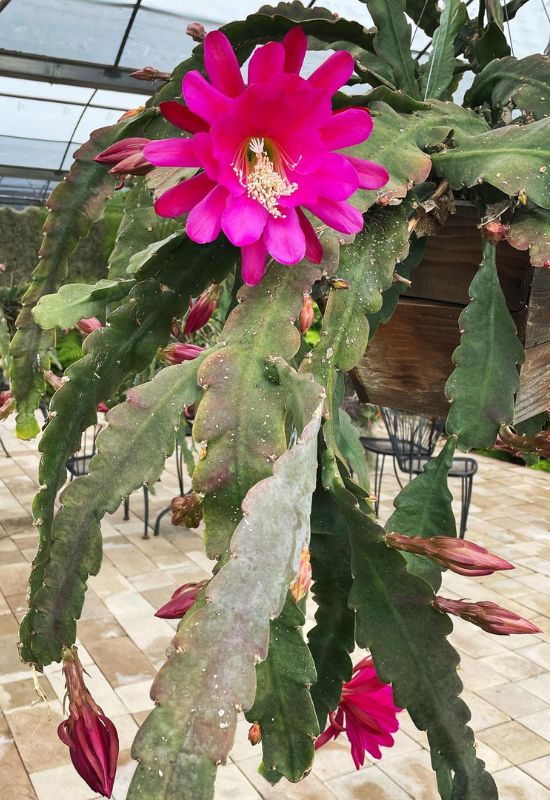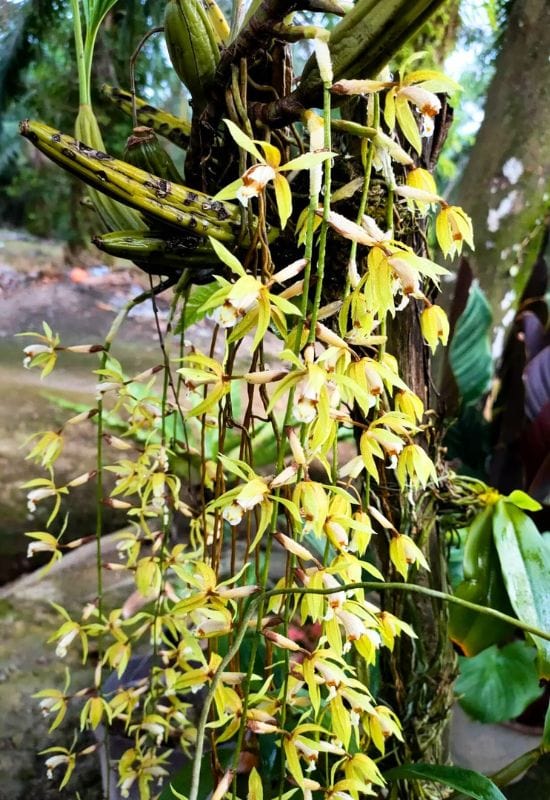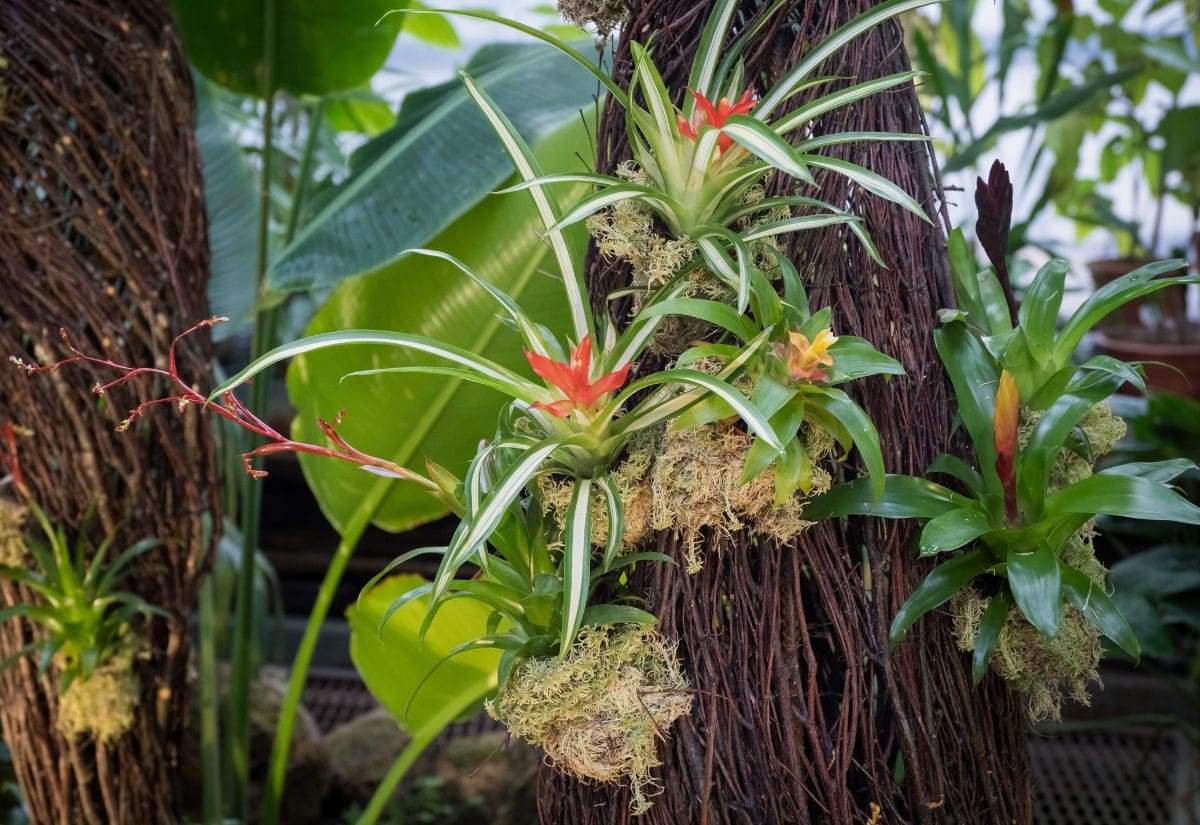
We think that plants need soil to grow… But it isn’t always true! Some, called epiphytes, literally grow on trees, nesting on their branches, and they send their aerial roots down to feed from humid air. And seeing their blossoms open with their bright colors among the foliage above your head is an experience you will never forget!
Many epiphytic plants are tropical and exotic as well, and maybe the best known are orchid species, including the popular Phalaenopsis, but some even consider mistletoe to be an epiphyte… The fact is that they bring blooms high up into your trees, adding that rainforest look to your house. Indeed, many epiphytic plants that grow on trees can also thrive as houseplants, and they do so with style!
So, if you want some flowers to blossom on the branches of the trees in your garden, or in your indoor spaces pick one of the epiphytic plant varieties that I have in store for you!
14 Types of Epiphytic Plants to Grow as Houseplants
And the trees in your garden will never look the same if you choose one of these super decorative epiphytic plants to grow among their branches!
For sure you already know the first epiphytic variety we would like you to meet, but maybe you thought it was just a houseplant? No, you can grow it outdoors on trees as well!
Moth Orchid (Phalaenopsis spp.)
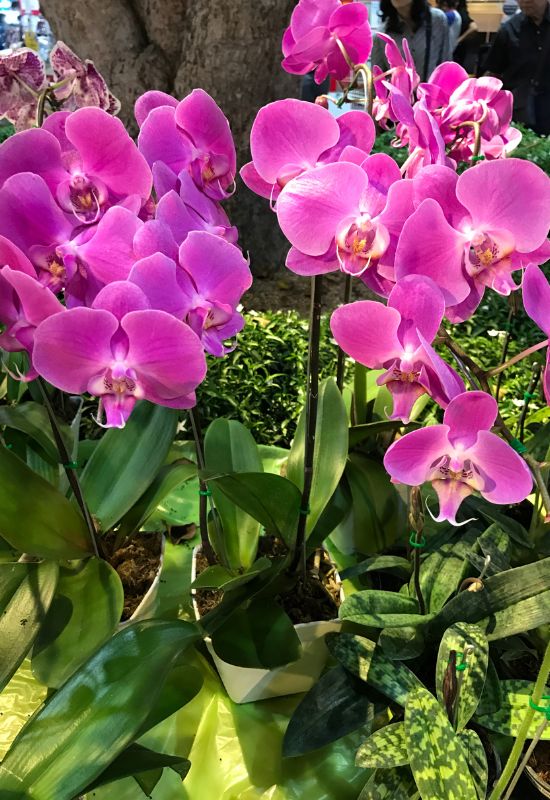
And we could only start with the most loved epiphyte in the whole world: moth orchid! Native to Southeast Asia, the Philippines and Australia, this genus has about 70 species, so you can really take your pick, because they are all epiphytes or lithophytes (they grow on rocks, a few).
And of course, they ate famous for their impressive blooms, which last, immutable, like immortal and peaceful miracles of Nature for months, in small clusters on long and sturdy stems. Famous for looking like butterflies, with fleshy and artistic petals, the modified one in the center, the labellum (or “lip”) is distinctively small, winged and usually of a different color from the others… Talking about shades…
Orchids are rally masters of tonalities, and you can get them all, apart from blue (you can with other genera). So, take your pick!
White, yellow, orange, pink, red, green, purple and even black are all possible in the super showy (sometimes fragrant) blossoms that you will see opening above your head among the branches of your trees.
Their evergreen leaves are a beauty to behold as well, leathery, oval and sometimes arching, very glossy and bright to dark green! And why not, even the aerial roots of these perennials are attractive! Descending from the leafy crown, they look like lianas from a rain forest!
Of course, you will need to live in a hot and humid country to enjoy any of the many moth orchid species (and even mote cultivars) blossoming on the branches of your trees. But if you are so lucky, there is no better plant to give you the full on exotic and tropical experience!
Air Plant (Tillandsia spp.)
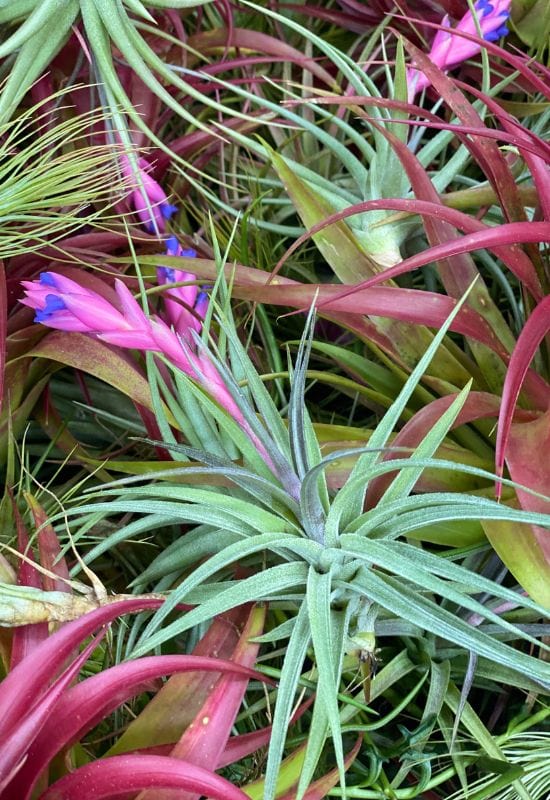
We call them air plants because they literally feed on air, and they are all the 650 species (and many cultivars) of the Tillandsia genus. They are actually members of the family of bromeliads (Bromeliaceae) and they are really all epiphytes!
Native to the Americas, they have found excellent “breeding ground” in rain forests as well mountain and deserts, so there are varieties for many growing conditions! And there are even some aerophytes, which means that they have a minimal root system and they live on shifty dunes… Small and elegant, these plants are famous for their colors…
These are not the actual flowers, which you will see in shades of violet and blue, mostly tubular, but in some cases opening to three elliptical petals, and sometimes with yellow… No, there is more… The fleshy modified leaves (bracts) that frame the real floral display are of the most amazing shades of red, pink, magenta, fuchsia… And of many creative shapes as well!
So, Tillandsia xerographica creates a plume of scarlet and straw, while pink quill (Tillandsia cyanea) has that strange shape like the tail of a beaver, with scales and of course, in romantic tonalities. The evergreen leaves are long, usually blade like but sometimes cylindrical, straight arching or even twisting, and they can be in a range of greens, often with a silver sheen.
Air plants are really the easiest epiphytes to fix on trees, and not only, as walls, big shells, even a lamp post will do! You can literally stick them with some waterproof plant safe glue to a spot and they will thrive and bloom freely!
Elkhorn Fern (Platyceriumbiforcatum)
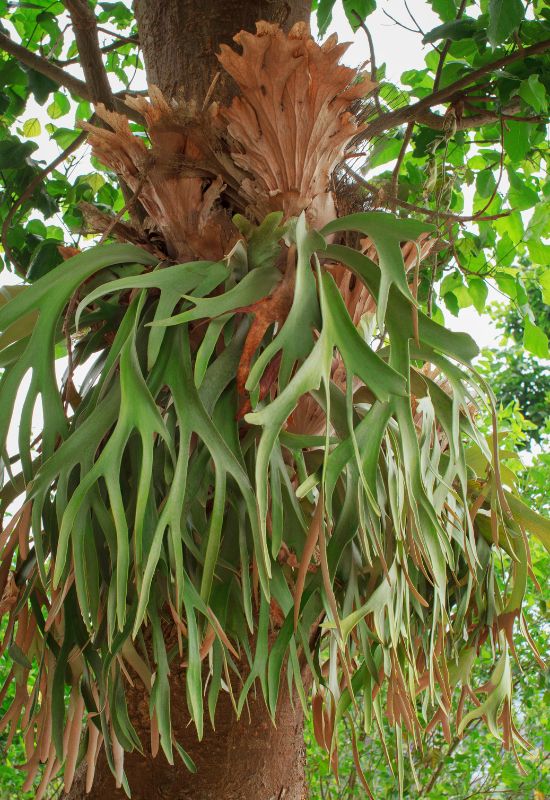
Ok, you won’t get any flowers with elkhorn fern, but you will still get an amazing effect, like living in a rainforest, with an exotic and very unusually looking tropical epiphyte! Native to Java, New Guinea and Australia, this leafy beauty is quite exceptional indeed… It has very smooth foliage, and of two types…
There are non fertile leaves – actually, fronds- which are artistically heart shaped and very decorative indeed.
These are between 5 and 18 inches long (12.5 to 45 cm). But unfortunately, it is the sterile ones that steal the show… They can reach an impressive 36 inches in length (90 cm)! And they arch beautifully, with bright green and gray as their colors… But the main asset of this evergreen foliage is that forked and strap shaped, and they do look like the horns of an elk!
Common as a houseplant, you can grow it on trees outdoors in sheltered locations, and it has won the prestigious Award of Garden Merit by the Royal Horticultural Society. If you want an even bolder variety, its sister Platyceriumelephantotishas really broad, flapping and veined leaves that look like elephant’s ears!
Looking up at elkhorn fern draping the branches of shady trees is like being transported into a corner of an exotic and tropical rainforest, and teletransported back in time into the world of Nineteenth Century explorers! Really a great asset for your garden.
Christmas Cactus (Schlumbergera spp.)
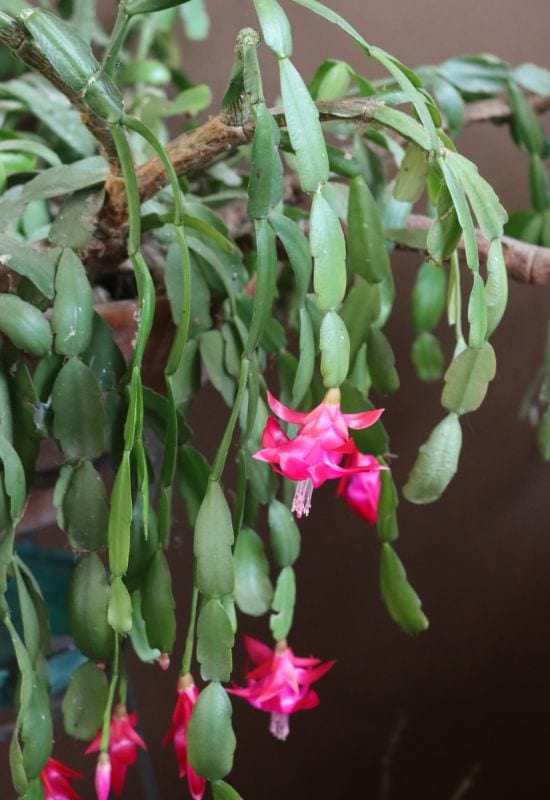
Christmas cactus is a popular houseplant, because it blossoms through winter and during the festive season it takes its name from. But this native succulent from South American rain forests will find an ideal habitat among the branches of your trees if you live in a hot country. Yes, because this beauty too is aepiphyte!
Actually, it is technically also a lithophyte (it grows on rocks), but it will equally enjoy a “wood house” and call it home.Loved for its very generous and bright blooms, that appear at the end of the stems, it is also very easy to propagate.
Its floral display will hang on the segmented and softly teethed arching and draping branches, which makes it ideal for places high up, above your head, or at eye level… The range of colors that the blossoms display is on the white to purple cline, with strong and vibrant pinks, fuchsia, magenta and red included.
There are bicolor varieties as well, among its nine species and many cultivars and hybrids. Light and graceful, it mixes the eye catching flowers with many rows of pointed petals with the deep green of the leaf-like little branches.
For a splash of energetic colors on the branches of your trees in winter, Christmas cactus is an ideal small and light draping plant, but remember that it needs regular watering, because, coming from forested areas, it is not as drought tolerant as other succulents.
Cattleya Orchid (Cattleya spp.)
If you really want to go sumptuous and super exotic, the orchids of the genus Cattley are unbeatable, and they too are epiphytic… In fact, they have adapted to grow on the branches and trunks of rainforest trees of South America, which is their ideal humid habitat.
While their moth sisters are more popular with amateurs, cattleyas are by far the tropical queens of greenhouses and botanical gardens. And this may be due to their big flowers (up to 9 inches across, or 22.5 cm!) which have all the colors of the rainbow in very vibrant shades and creative combinations…
They also come in small racemes on upright stems… Or maybe it is because they have five frilly petals that frame the central one, the labellum, and this is amazingly decorative, elongated and opening to a large lip, often in a different shade from the others?
Perhaps, the fleshy, oval and glossy emerald green leaves play a role in this? Or it may be that the pseudobulbs they have at the base add yet another asset to these plants? For sure, with more than 120 species and innumerable cultivars, you have a really wide choice for your garden!
Yes, do grow a cattleya (or more) on the trees of your garden if you can afford it, but do keep it at about eye level, or just above, because they are so beautiful and showy that they do deserve a prominent position.
Spanish Moss (Tillandsia usneoides)
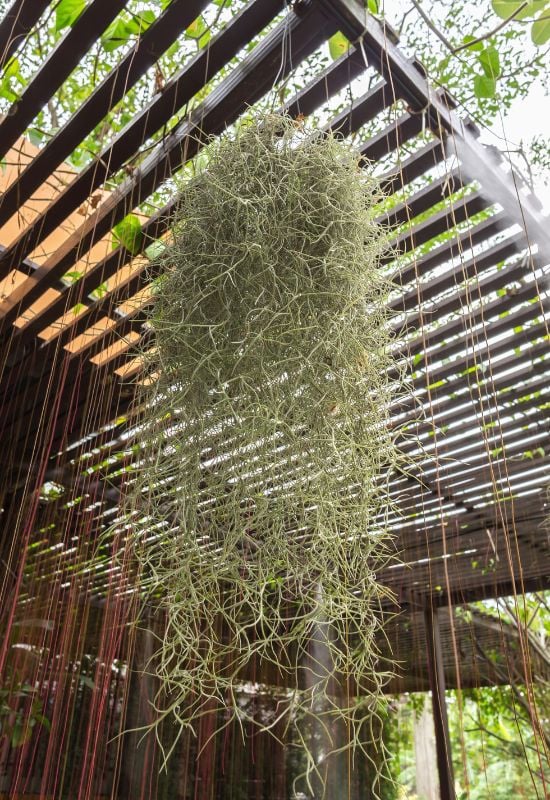
Spanish moss is actually a species of Tillandsia, but it is the odd one out in the genus. And in fact you will be hard put to recognize it as an air plant. Native to the south of the USA, Central and South America, this epiphyte has a look of its own, almost spooky, something that would look great at Halloween parties…
In fact, it clings to branches and then it sends down a mesh, like a fishing net, or a cobweb of dense whitish “threads” or “filaments” that form a curtain that can reach 20 feet long (6.0 meters).
These are actually very fine stems that interweave and tangle, while the leaves are scaly and curly, about 0.8 to 2.4 inches long (2.0 to 6.0 cm). While you may think that these are aerial roots, they are not, and in fact, this epiphyte has no radical system at all: it takes all its nutrients from these unusual “hair”, which give it the nickname “grandpa’s beard”…
It is a flowering plant, but the little blossoms are inconspicuous and they can be green, yellow or even, unusually, gray… But they are pretty if you look at them closely, with three waxy petals and a tiny orange dot in the center, opening like pearls on a lace veil.
The best trees to grow Spanish moss on are oaks (Quercus) and bald cypress (Taxodium distichum), but you can make do with other species if you don’t have one, and it is certainly the best epiphytic variety for a very unusual, even ghostly effect, but always with an exotic and tropical twist.
Queen of the Night (Epiphyllum oxypetalum)
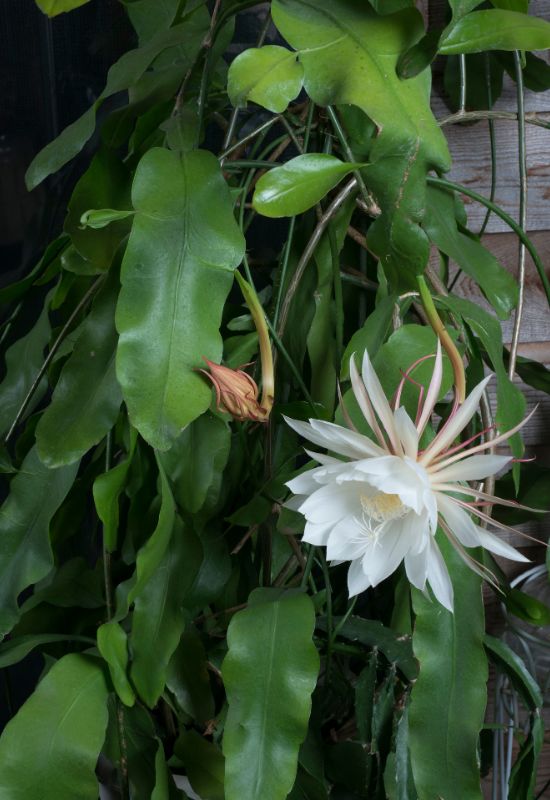
A lunar beauty from Central and South America, queen of the night is a spineless cactus variety with amazing decorative value, but it is quite easy to grow. As its binomial name suggests (Epiphyllum oxypetalum) it is an epiphyte and also a litophyte, and it is a popular houseplant, but it likes the open air, and it enjoys sending its long, succulent and trailing stems down from the branches of trees, where you can enjoy their glossy emerald green color and wavy edges…
And, when spring comes to a close, it will also blossom… And it will do it with a bang! Yes, because its flowers are huge, up to 8 inches wide, snow white and very long as well!
They are actually funnel shaped, but they open to a cupped mouth with three rows of pointed petals, like short swords, and they are backed by long, almost needle like “rays” that form a star around them, and these can keep a pink to purplish coloring… Finally, these are very, very fragrant and, true to its reputation, they open at night and they close during the day.
A real star of the epiphytic world, queen of the night is a super showy cactus to give your garden a flamboyant but elegant, exotic but fresh and bright look. Of course, unlike many other epiphytes, it is also drought tolerant!
Vriesea (Vriesea spp.)
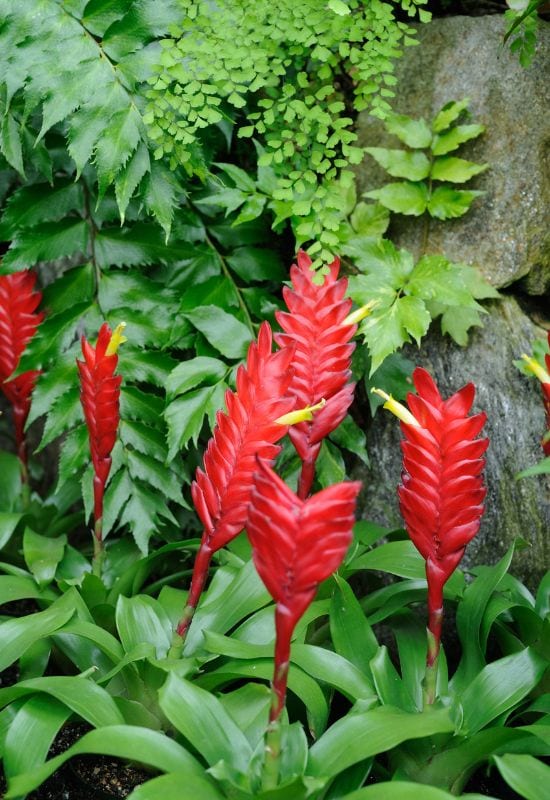
Native to Central and South America, vriesea is a large genus with about 150 species, and most of them (not all), are epiphytes and they grow on the branches of trees in humid tropical and subtropical areas. A close relative of bromeliads (it is actually one of them) and tillandsias, it is also a popular houseplant, but with its own peculiarities.
In fact, they will bear their blooms on upright stems, not close to the rest of the foliage, and they accompany them with amazing waxy bracts that usually form a flattened rattlesnake tail shape. However.
Some can take different embodiments, like plumes, for example. These are of the brightest colors ever, with red, even pure scarlet, golden yellow, lime, orange, pink, rose and even lavender! These long displays can last for up to three whole months!
However, then your plant will die. The actual flowers hide between these scaly bracts till they open, and they can be tubular or have spread out petals, usually yellow, violet, purple or even blue! Then, the seeds will fly away with feathery wings, a bit like dandelions do!
The succulent leaves form a decorative rosette at the base, and they are very glossy, usually emerald green, but there are variegated varieties too! And they can be oval and broad, or sometimes narrow and pointed, like grass blades.
Small and fairly easy to care for, vriesea can be a very colorful presence among the branches of your trees; but, despite being a succulent, it will need regular and generous watering. Having said this, it has a quirky and exotic personality that can really lift any garden.
Dendrobium Orchid (Dendrobium spp.)
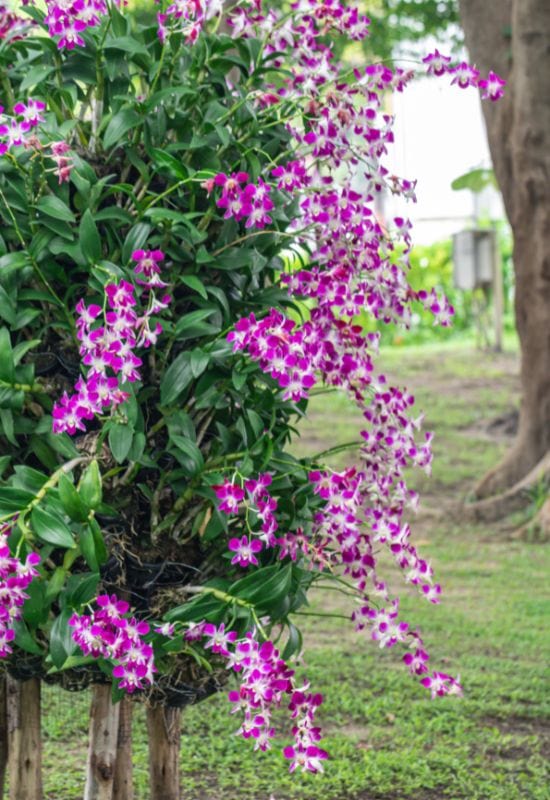
Also sometimes called bamboo orchid, Dendrobium is a vast genus from Southeast Asia and some pacific islands, and most of the 1,800 species (!!!) are epiphytic and litophytic varieties. They include some that produce such massive racemes that they really take your breath away!
Others have fewer blossoms on their stems, but they are always extremely showy, and a wonder to have in any garden! Like all the members of this great family, they are distinctive because one petal, the labellum is different in shape (and usually in color) from all the others… And in this case, it is is usually egg shaped, often filled, and it extends forward, but not as much as in a cattleya.
In some species, it can be extremely broad and rounded as well. The range of shades is, as you may expect., extraordinary, with white being very common, but also pinks, greens, yellows and purples (to almost black)! And you can get the most amazing tonalities on this palette, from bright and powerful to soft and sophisticated!
Each blossom can last to up to 6 weeks, and the whole display for months! The leaves are typically emerald, fleshy, glossy and oval in shape, and its nickname may come from the fact that some have stems that look like canes…
One of the most generous bloomers among orchids, dendrobiums can really turn the branches of your trees into aaerial garden filled with flowers, colors and exotic shapes.
Bromeliads (Bromeliaceae Family)
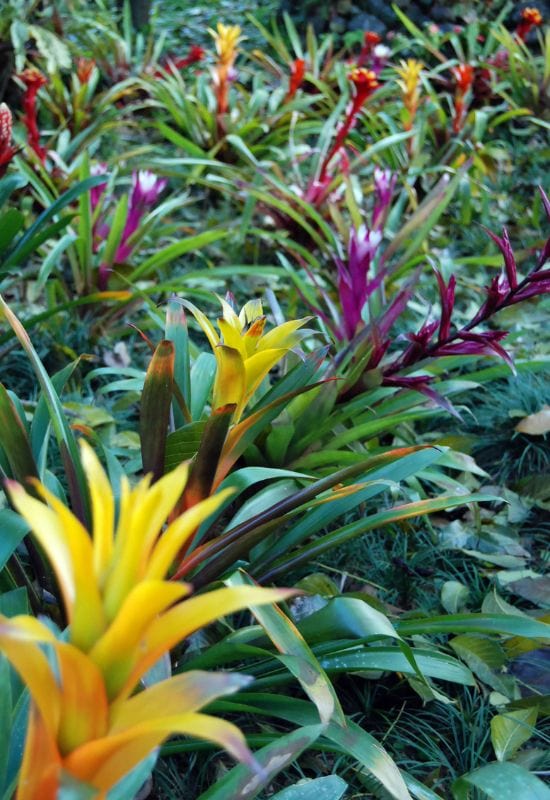
Bromeliads are a huge number of plants, in fact, they are a whole family with 72 genera and a whopping 2,700 species! However, when we use this term we mainly refer to the Bromelioidaeaesubfamily (urn plant and relatives) and the Guzmaniagenus, which has become a very popular houseplant!
And they do deserve a special place on our list, because, of course, most are epiphytes or litophytes! And they will look great nestled on the branches of your garden’s trees! They will produce colorful bracts, in bright and vibrant shades of red, orange, pink or yellow once they are ready to blossom.
This can happen at any time of the year, and it will last a very long time indeed, about three months! However, this will also spell the departure of these plants from our world… But never mind, they may produce pups and you will get a new generation, and then enjoy the flowers.
These are usually blue or violet, often tubular and popping out from between these modified leaves, but sometimes they have three spread out petals. The foliage is always lush, in many colors, from ice blue to dark emerald green; some are very glossy, others have a dusting on them, but they are always succulent and they always form very sculptural rosettes indeed!
Fairly easy to grow and very easy to find on the market as houseplants, bromeliads will love growing on trees in hot and humid regions, and those colorful rosettes growing on branches are a really exotic wonder indeed!
Bird’s Nest Fern (Asplenium nidus)
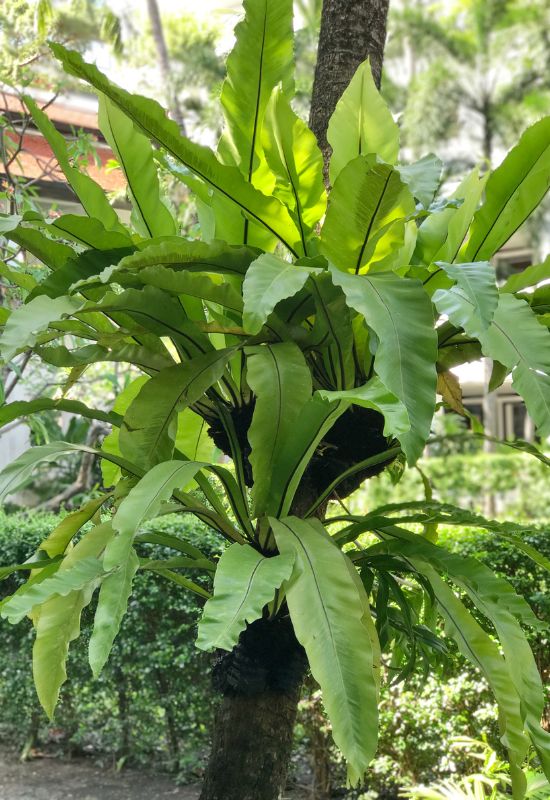
Yet another exotic perennial that likes to grow on trees is bird’s nest fern, a popular houseplant. In fact, it is native of tropical forests of Southeast Asia, Australia and Hawaii, and it has lots to offer to open gardens in hot countries… Its suggestive name comes from the shape that the foliage takes, a wide and open rosette.
But it tells us little about other assets of this epiphytic variety… For example, it does not tell us that the fronds are super glossy, to the point of shining! And it does not tell us that they are of the most exquisite emerald green color you will ever see… Nor does it tell us that they are wavy at the margins, and new shoots curl up elegantly at the tips.
All this is in contrast with the straight mid rib, which takes up a pale shade on the upper pages, but tends to dark brown underneath. And there, regular lines of spores will radiate towards the edges when it is fertile. Growing it over you head, nestled between shady branches also means having a winner of the coveted Award of Garden Merit by the Royal Horticultural Society in your collection.
Easy to grow and very easy to find, bird’s nest fern can give you lush and glossy evergreen foliage to grow on trees, for a fully complete and florid tropical and exotic look. What is more, it can grow well even in deep shade!
Orchid Cactus (Disocactus ackermannii)
Evocatively called orchid cactus, Disocactusackermanii is an epiphytic succulent species of the Cactaceaefamily that grows on the tall trees of the forests of some southern states of Mexico (Chiapas, Oaxaca, Puebla and Veracruz).
This plant grows on short stems, only about 4 to 7 inches long (10 to 18 cm), but there, develops segments of flattened leaves, that can be 30 inches long (75 cm), wavy at the edges, and similar, but on a bigger scale, to those of Christmas cactus… These arch downwards, descending from the leafy crowns above you head… And with thus draping habit, they bring their impressive blossoms to your eyes!
The fiery spectacle will light up in mid spring, when you will see scarlet red flowers opening at the tips. These are quite big, about 6 inches long (15 cm) and across, funnel shared and opening wide at the mouth, revealing rows of pointed and elliptical petals with a shiny waxy texture.
In the middle, you will enjoy long and thin, straight filaments in the same color, though they may turn green at the ends. At the back, long and sword like petals will form rays, like in a star. There are also varieties in magenta and rose pink! And these arealsofollowed by egg shaped, greenish to reddish brown fruits, which are edible and deliciously sweet!
Orchid cactus likes cloud forests at high altitude, not just tall trees… It likes both hot conditions and high humidity levels. But if you can afford these, this epiphytic cactus will definitely lift up any garden with its exotic and energetic, showy blooms!
Coelogyne Rochussenii (Coelogyne rochussenii)
Here is another orchid for you, and there are many more from the Orchideaceaefamily, but this needs a mention: Coelogynerochussenii… To start with, it is a bit more hardy than other epiphytic varieties, while there are many terrestrial species you can grow in temperate regions… But there is more… This native beauty has its habitat on the branches of high altitudetropical trees in Borneo, Java, Sumatra and some of the Philippine islands… And it is very special indeed!
In fact, its exotic looking blossoms will come on long pendulous spikes, up to 2 feet in length (60 cm)! And you will get up to 50 (!!!) flowers on each, and many a drooping cluster per plant! Even a dozen! It’s like having floral waterfalls coming down from above! Each blossom is about 2.5 inches across (6.25 cm), and – they can blossom at any time of the year!
They are cream in color, with variations and many shades, from yellowish to greenish and brownish, a long, vase like arching labellum with an extended white “tongue” at the bottom and an orange lip at the top! The other petals are long and pointed, forming a decorative star.
They open in the morning and close slightly at night, and they have a strong lemon like scent as well! And the foliage? The leaves grow above this floral display, and they form lovely tufts of ovate, arching and fleshy leaves with a bright emerald and glossy sheen!
A really fantastic epiphyte, Coelogynerochusseniiis the orchid you want if you wish to be original and at the same time wow your guests with a its amazing, long lasting, and really weeping blossoms! Just spectacular coming down from tree branches!
Mistletoe (Viscum album)
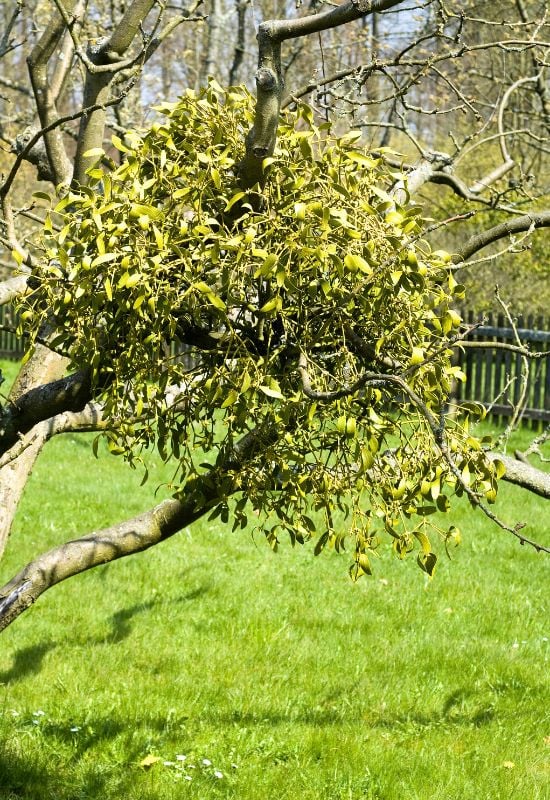
There are many genera of mistletoe, including Phoradendronfrom North America and Arceuthobium from all over the world, basically, but we would like to focus on the most classic of all: Viscum album from Europe… But is it anepiphyte?
Well, it grows on trees, but it is also a hemi-parassitic plant, meaning that it takes nutrients from its host, not from the air… Nevertheless, some regard it as a an epiphytic shrub, at least in behavior and habitat… Yes, it is actually a little evergreen bush, with strap like, very leathery and glossy leaves that grow to 3.15 inches long (8.0 cm) and they are very glossy indeed.
It also a flowering plant… Its little blossoms will appear at the armpits of the petioles, at the tips of the little segmented branches in spring and summer. They are tiny, but very fleshy and mainly dark yellow, but sometimes they have white in them as well.
But of course, it is mainlyfamous for its round and viscous, translucent fruits, which persist into the winter months, and they are very decorative, on top of bringing good luck! One note, each berry usually contains only one seed.
If you live in a temperate or cold region, it is hard to fond an epiphyte to grow on the branches of your trees. No, you won’t have orchids flowering above your head… But you can still grow humble but beautiful mistletoe. Do keep it in check, because it could become problematic. Its favorite hosts are apples, limes and lindens, hawthorn and poplars, while its American sister, Arceuthobium, prefers pines and cypresses.
Epiphytes for a Garden in the Sky!
True, most epiphytic varieties are exotic and tropical, but if you have the right growing conditions, these varieties (and many more orchids), can literally give you a little garden nestled among the branches of your tree, and a full on rainforest landscape!

Written By
Amber Noyes
Amber Noyes was born and raised in a suburban California town, San Mateo. She holds a master’s degree in horticulture from the University of California as well as a BS in Biology from the University of San Francisco. With experience working on an organic farm, water conservation research, farmers’ markets, and plant nursery, she understands what makes plants thrive and how we can better understand the connection between microclimate and plant health. When she’s not on the land, Amber loves informing people of new ideas/things related to gardening, especially organic gardening, houseplants, and growing plants in a small space.

